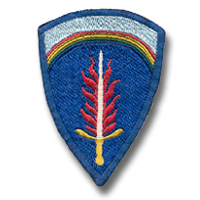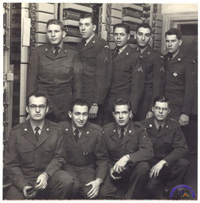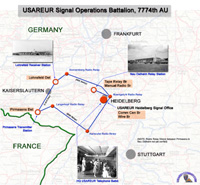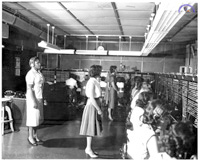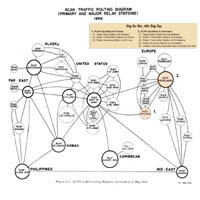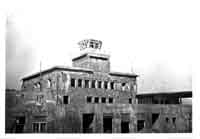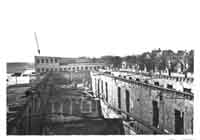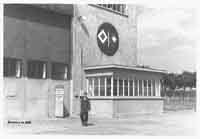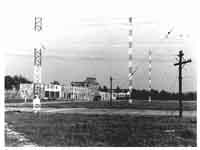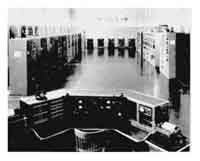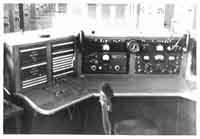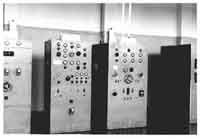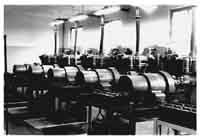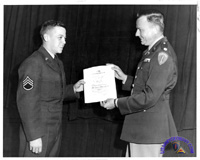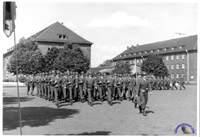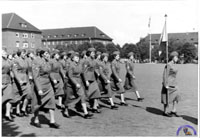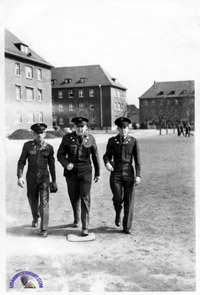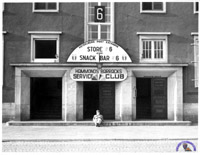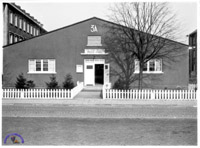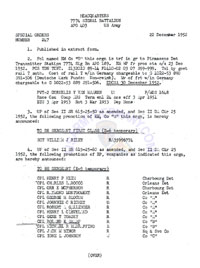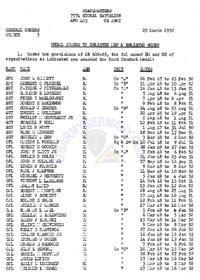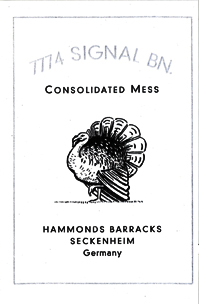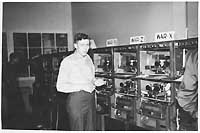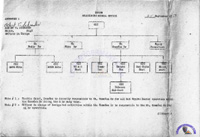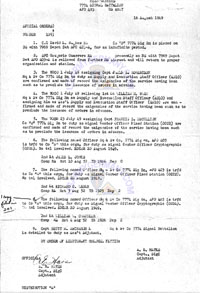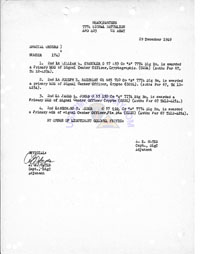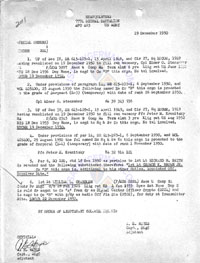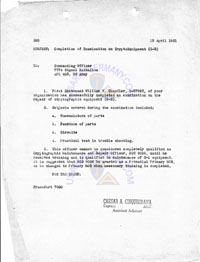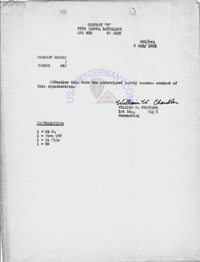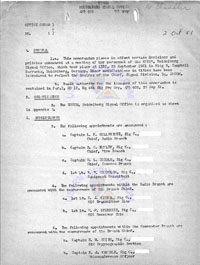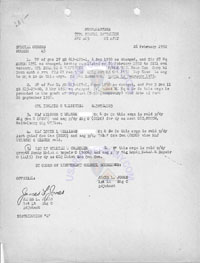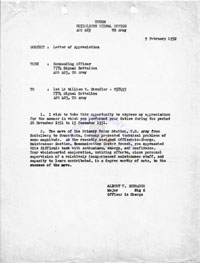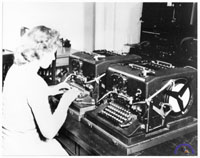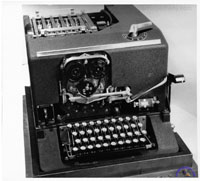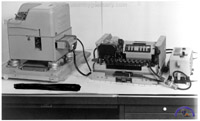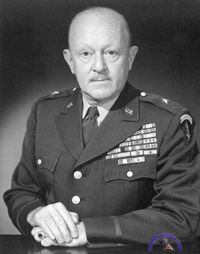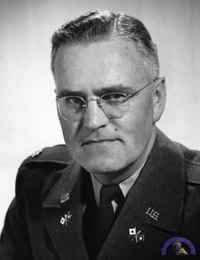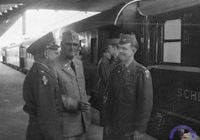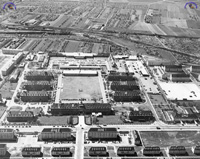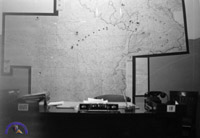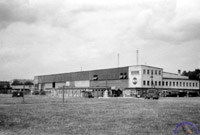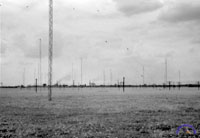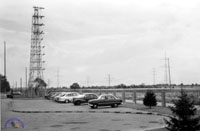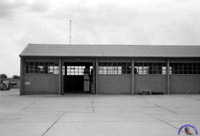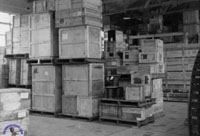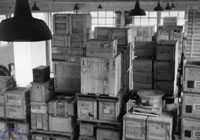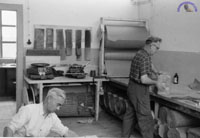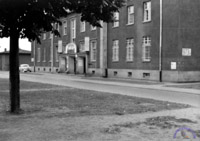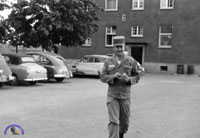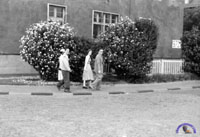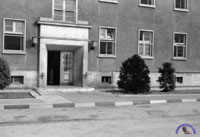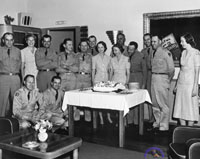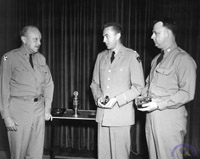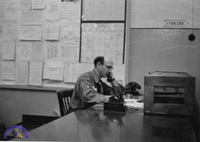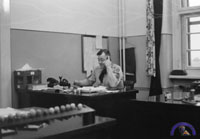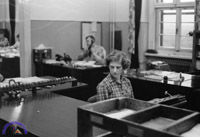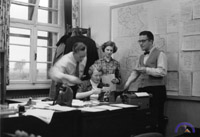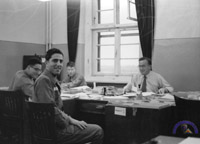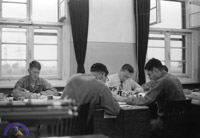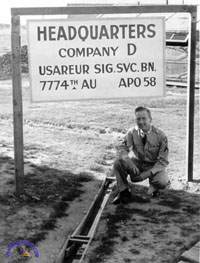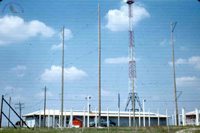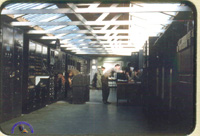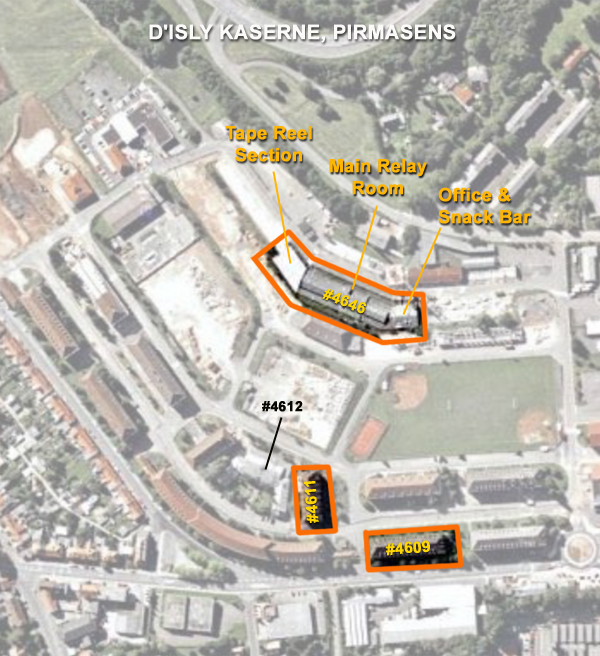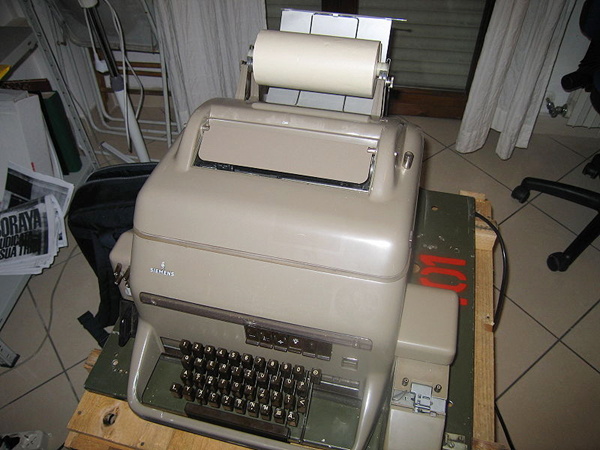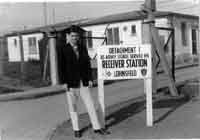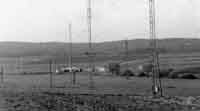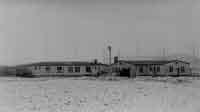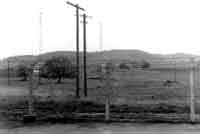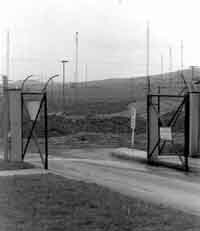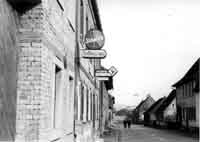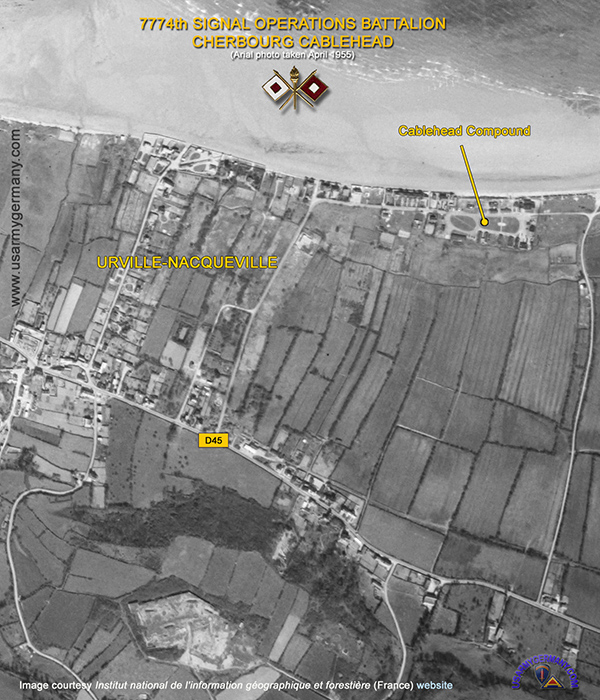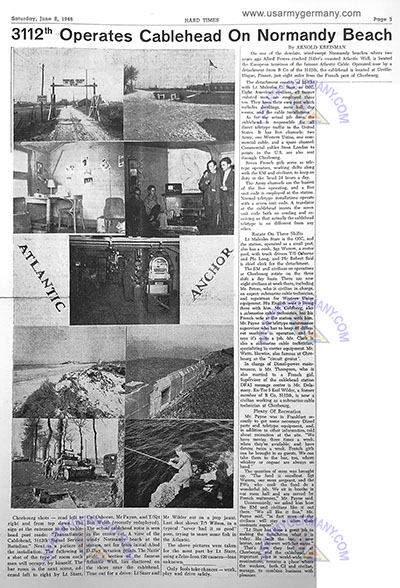| If you do
NOT see the Table of Contents frame to the left of this page, then
Click here to open 'USArmyGermany' frameset |
||||||||||||||||||||||||||||||||
|
7774th
Signal Battalion |
||||||||||||||||||||||||||||||||
|
|
||||||||||||||||||||||||||||||||
|
||||||||||||||||||||||||||||||||
|
|
||||||||||||||||||||||||||||||||
%20Seckenheim%20sign%201946%20600.jpg) Sign on road to Loretto Kaserne, 7774th Sig Bn headquarters, 1946 (Webmaster's collection) |
||||||||||||||||||||||||||||||||
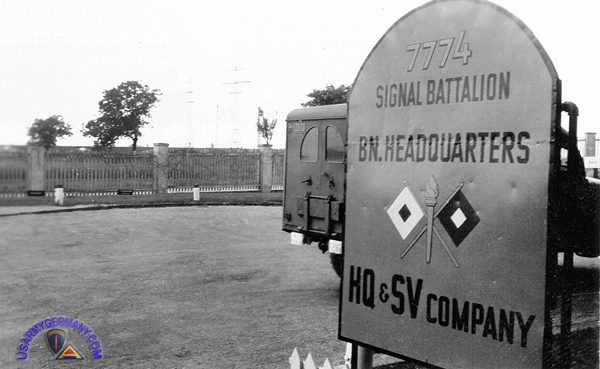 HQ & Svc Company sign at Seckenheim headquarters, 1952 (Sandy Rini) |
||||||||||||||||||||||||||||||||
| Battalion History | ||||||||||||||||||||||||||||||||
| 1949 | ||||||||||||||||||||||||||||||||
| (Source: STARS & STRIPES, May 22, 1949) | ||||||||||||||||||||||||||||||||
| The EUCOM Signal Office, Heidelberg, includes the following activities: |
||||||||||||||||||||||||||||||||
| 1953 | ||||||||||||||||||||||||||||||||
| (Source: Email from Norman Shapp) | ||||||||||||||||||||||||||||||||
| I came upon this website while looking for info about my old outfit in Heidelberg, Germany. I was with the 7774 Signal Battalion, connected to the headquarters of USAREUR (Flaming Sword). Although we had detachments all over (Orleans, Kaiserslauten, & others I can't think of now, the higher-ups decided that we needed one in Paris. I, a private at the time, and a complete complement of 50, including officers, communications specialists, etc, were sent to the Blockhouse at 50 Rue La Perouse in Paris. This was in about Feb-Mar 1953. We ran a 24/7 operation including a code room. We shared the building with NATO. There was no barracks for us so we lived in hotels nearby, and most guys hung out in the American Bar where all the hookers were. I may have a few photos outside, but we were not permitted photographing inside. At that time I never heard of these other Signal Companies. |
||||||||||||||||||||||||||||||||
| 1954 | ||||||||||||||||||||||||||||||||
| (Source: Annual Historical Report, 1 January 1954 - 31 December 1954, USAREUR Signal Operations Battalion, 7774 AU, APO 403) | ||||||||||||||||||||||||||||||||
| The 7774th Signal Battalion was activated on June 20 1947. | ||||||||||||||||||||||||||||||||
|
||||||||||||||||||||||||||||||||
| In 1948, due
to mass reduction in strength, the Battalion was redes as 7774th
Signal Service Company. On Jan 10 1949, the 7774th was redes as 7774th Signal Battalion. The Battalion operated without detachments until Feb 10 1952, when the Cherbourg Det was activated. Other dets were formed later: |
||||||||||||||||||||||||||||||||
|
||||||||||||||||||||||||||||||||
| Due to their
distance from the parent unit, these dets were attached to other local
units for logistical and administrative support while the Battalion
retained command and operational control over them. Similarly, several units were attached to the 7774th for like reasons: |
||||||||||||||||||||||||||||||||
|
||||||||||||||||||||||||||||||||
| On March 15 1954, the 7774th Sig Bn was reorganized and redesignated as USAREUR Signal Operations Battalion, 7774th Army Unit under USAREUR GO #26, Feb 24 1954. All personnel were assigned to lettered companies in relation to their normal duties: | ||||||||||||||||||||||||||||||||
|
||||||||||||||||||||||||||||||||
| The Battalion is currently (1954) assigned to the 4th Signal Group (which is assigned to Signal Division, Headquarters USAREUR). | ||||||||||||||||||||||||||||||||
| The USAREUR Heidelberg Signal Office is designed to carry out the operational phase of the 7774th AU's mission: to provide signal communications for the Commanding General, USAREUR and his staff. | ||||||||||||||||||||||||||||||||
| Prior to Jul 1 1955, Lohnsfeld Det was redes Signal Operations Battalion, which was later redes Signal Service Battalion. | ||||||||||||||||||||||||||||||||
| More to follow | ||||||||||||||||||||||||||||||||
| If you have more
information on the history or organization of the 7774th Sig Bn, please
contact me |
||||||||||||||||||||||||||||||||
|
|
||||||||||||||||||||||||||||||||
| (Source: Email from Armand Maccarone) | ||||||||||||||||||||||||||||||||
|
||||||||||||||||||||||||||||||||
| 1956 | ||||||||||||||||||||||||||||||||
| (Source: STARS & STRIPES, August 3, 1956) | ||||||||||||||||||||||||||||||||
|
||||||||||||||||||||||||||||||||
| Besides the regular calls handled by the DCO, the 26-position HQ USAREUR Telephone Switchboard handles about 7,000 calls a day. Wire Branch not only handles local communications but also long-distance (overseas) communication. In fact, the DCO at Heidelberg is the Army's main installation of that type in Europe. Besides telephone calls, Wire Branch performs other activities: operation of several intercom systems; radio control circuits; installation and maintenance of all underground cable in the area; an "alternate communication system" (anybody have information on that?), and a repair shop for telephones. Communications Center Branch -- located in the same building as the military telephone exchange, is responsible for electronically transmitting official messages for the Commander-in-Chief of USAREUR, his staff, and other units as designated by the Signal Officer, USAREUR. The CommCen combines several different operations that include Manual Radio, Message Center, and a Crypto Center. A brief look at the routing procedure for incoming and outgoing messages helps explain the workings of the Comm Cen. An incoming message passes through a portion of the ACAN network to a terminating station. As soon as the message is received, it is checked by the in-clerk who makes three copies of the message -- one copy is filed and two copies are sent to Staff Message Control where the message is checked for procedure and legibility. Before the message is forwarded to the Message Center, Staff Message Control stamps the message with the date and time received. At the Message Center the message is checked again and then sent to the router. Here it is determined if the message is to be sent by teletype or radio and given the proper routing indicator. If it is to be sent by radio, it goes to the Manual Radio (Branch) from where it is sent out over the radio network. The Crypto Center deals with classified messages. In the crypto room classified messages are encrypted and decrypted by the use of authorized systems. This section works under strict security regulations; personnel working in this section must have security clearance. Manual Radio Branch -- maintains circuits linking headquarters with all subordinate commands, some tactical commands and other NATO forces in Germany. Normally the primary function of Manual Radio is to provide back-up circuits for teletype. In Europe the tactical circuits are small and mobile. These tactical units handle military operations of lower level communications. Manual radio circuits also link HQ USAREUR with several American embassies, missions, and advisory groups outside of Germany. Two other subordinate units of the Manual Radio Branch are the Military Affiliate Radio System (MARS) and Facsimile. MARS is a system designed to train civilian operators in military procedure and organize them into nets so that in an emergency they can transmit messages. Facsimile is a means of transmitting photographs, maps, and sketches by electrical means. Tape Relay Branch -- located at Neu Ostheim (former German fliegerhorst), about six miles from Heidelberg. The mission of the Tape Relay Branch is to operate and maintain the Primary Relay Station RUFP and provide any communications services as directed by the USAREUR Signal Officer. The Neu Ostheim Tape Relay Branch is one of nine primary relay stations within the ACAN system and serves as the Net Control Station for the European-African area. |
||||||||||||||||||||||||||||||||
|
||||||||||||||||||||||||||||||||
| Pirmasens Detachment -- operates high-frequency radio transmitters that provide high-powered long-distance communications to other ACAN stations in many parts of the world. Looking for anyone who can provide some photos (from the 1950s/60s) and details on the Pirmasens Transmitter Station! Lohnsfeld Detachment (follow link) -- is responsible for operating a HF receiver station that receives radio transmissions from other ACAN stations throughout the world. The radio signals received by the station are transferred to the Facilities Control Section at Neu Ostheim where they are distributed to the various operational branches for further processing. |
||||||||||||||||||||||||||||||||
| Memories | ||||||||||||||||||||||||||||||||
| 1949 | ||||||||||||||||||||||||||||||||
| (Email from Jack W. Ransone, with the 7774th Sig Bn in 1948-49) | ||||||||||||||||||||||||||||||||
| I arrived in
Seckenheim at Hammond Barracks on December 14, 1948. January 1949 we started work at the Mannheim Airport in Neuostheim. The airport was a Germany fighter base (see attached photos 2 ). Engineers and civilians were to repair the hanger area and officer quarters which we occupied. This site was known as (AGA). Transmitters were installed, Embassy Net, Berlin Net (AGB) (WAR) in Virginia. WAR was a 50KW singleside band, 10 channels. Power was supplied by six diesel generators. After repairs were completed we moved from Hammond to the site as a detachment. We had three shifts. Later a motor pool unit occupied the other hanger area. Some wild forays soon developed. I have many photos of the inside of the site, you are welcome to them. The GI's who formed up at Hammond came mostly from the states as I did in Dec 48, the civilian engineers were on site repairing the buildings. There was a mobile unit (at the airfield) that operated out of four or five large radio vans with their own trailer mounted generators. They were somewhat a mystery and operated at a distance on the air strips. However, after we became operational our unit aquired this equipment. |
||||||||||||||||||||||||||||||||
|
||||||||||||||||||||||||||||||||
|
|
||||||||||||||||||||||||||||||||
| (Source: Email from Roland E. Sharp, Co "B," 7774th Sig Bn, Dec 1948-Dec 1953) | ||||||||||||||||||||||||||||||||
| I was stationed at Hammond Barracks with the 7774 Signal Battalion from December 1948 to December 1953. I was a member of Company B most of the time I was there. Company A and D were also there and Company C which was a WAC unit was stationed at Patton Barracks in Heidelberg. My duty station was at European Command Headquarters in the Manual Radio Section when I first arrived there. The unit was designated the 7774 Signal Service Company at that time. I don't remember when the unit was changed to the 7774 Signal Battalion (Webmaster Note: Jan 1949.) The Manual Radio section was on the second floor of the communications building. On the first floor was the teletype room and code room where the messages were decoded and encoded (messages were mainly sent and received by Morse Code in five letter code groups ). We were the Network Control Station for three networks in Germany with about fifteen stations in Stuttgart, Munich, Wurzburg, Nuremberg, Augsburg, Wiesbaden and others. Later we had contact with U.S. embassies in Belgrade, Yugoslavia, Budapest, Hungary, Warsaw, Poland, Ankara, Turkey. We also were the control station for U.S. Sea Transport Service. I was promoted to Pfc., Corporal and Sergeant while with the unit. I transferred to the Teletype Section and was NCOIC of the communications section. I was also a radio operator aboard General Handy's train. The other unit stationed at Hammond Barracks was the 7809 Station Complement Unit. Also, the Heidelberg Military Post Headquarters was there. There was a bowling alley, movie house, EM club and Service Club. When I first arrived at Hammond Barracks the mess hall was shared by both units. Later a mess hall was built for the 7774 unit. My enlistment period was for three years but in 1951 when my enlistment was to be ended we were required to serve longer and I re-enlisted for three more years, received a 40-day leave home, $300 re-enlistment bonus and returned to my unit in April 1951. I was named Soldier of the Month in September 1953 and received a certificate, a photograph displayed in the mess hall and a photograph of me shaking hands with the commanding officer, Lt. Col. Stanley S. Ehresman. While I was stationed in Europe I was able to travel on furloughs to Amsterdam, Brussels, Paris, Nice, Geneva, Berne, Venice, Rome, and Vienna. ADDITIONAL INFORMATION I enlisted in the Army on February 11, 1948, at the age of 18, being sworn in at Kansas City, Missouri, took my basic training at Fort Knox, Kentucky, with the 3rd Armored Division which was a training unit at that time. I went to radio school at Fort Monmouth, New Jersey for six months training as a radio operator. I graduated with an MOS 766 which was a high-speed radio operator, being able to send and receive at 25 words a minute. We copied Morse code with a typewriter so I had to learn to type at the same time I was learning Morse code. After a short leave to my home in Pittsburg, Kansas I reported to Camp Kilmer, New Jersey for overseas duty. We crossed the ocean on the USTS General Maurice Rose leaving New York Harbor about December 10 and arrived at Bremerhaven, Germany about December 20. We went up the English Channel which was very rough at that time of year. I was seasick for most of the ten day crossing. From Bremerhaven I was sent to Marburg Replacement Depot and arrived in Heidelberg about December 22 or 23. The Communications Center at EUCOM headquarters operated 24 hours a day. We worked an eight hour shift 6 days at a time, had two days off, and went back on a different shift. rotating shift times every eight days. We had four operators on each team, operating as network control station for three networks. The four of us on the same team roomed together in a four man room and got to be very good friends. I kept in touch with two of them over the years and those two have died within the last five years. They both stayed in the service for over 20 years and then retired. The three of us rotated as operators on the commanding general's train. I left the Army in February 1954 with six years service. I have a number of photos taken at Hammond Barracks showing the different buildings. At that time there were four barracks buildings. One was for the 7809 SCU and the others were Hq. Company, Company A and Company B. Also Heidelberg Military Post Headquarters was there. The 7809 and 7774 alternated for guard duty I think a week at a time. There was an EM club, bowling lanes, movie theater all in the same building, and a service club where the PX, barber shop (25 cents) and library were located. Cigarettes were $1.10 a carton and we could buy only 1 carton per week. A carton sold for about $25.00 each on the German black market. Coffee, silk stockings, tea were also big sellers on the black market. The barracks were kept clean by German women hired for the purpose. The KP duty at the mess hall was also done by Germans. We also had some Germans doing non-classified jobs at EUCOM. |
||||||||||||||||||||||||||||||||
|
||||||||||||||||||||||||||||||||
| (Email from John Wilkins, with the 7774th Sig Bn, 1949-53) | ||||||||||||||||||||||||||||||||
|
||||||||||||||||||||||||||||||||
|
|
||||||||||||||||||||||||||||||||
| (Source: Email from William Chandler, 7774 Sig Bn, June 1949-1952) | ||||||||||||||||||||||||||||||||
| I reported to the 7774 Sig Bn in June 1949, as a 2nd Lt just out of the SigO Basic Course at Ft Monmouth. After service in WWII as a S/Sgt in the Manhattan Project, I received my commission through ROTC at Ohio State and attended The Ground General School at Ft Riley after accepting a commission in the Regular Army. I was assigned to Charlie Shift in the Code Room, UFPCR, and served under the Bn CO, LTC Fettig, and the CommCtr CO, WAC Maj Nell Farnum. The EUCOM CSigO, MG Matejka, decided that enlisted men were a security risk, so he reassigned all the men and we were left with only enlisted WACs in the Code Room. My shift was fortunate because we had trained the WACs to route messages. I was on duty the night that the Korean War started; we thought that Kimpo AFB was a garble and serviced the message. After a few months I was reassigned to Co B as a Transmitter Site Duty Officer in Neuosteheim. Then the Crypto Maintenance Officer was reassigned and I went to Frankfurt to pass the ASA tests, then became Crypto Maintenance. Later I was assigned as the Signal Equipment and Repair Officer when we moved the CommCenter from Campbell Barracks to Neuostheim. I left the Battalion in 1952. I continued my Army service until 1975, serving in various Signal slots that included a position on the USMA faculty, commanded the 54th Signal Bn in Viet Nam, 1966-67, and Commanded DCA-Pacific 1971-73. I attended the Inter-American Defense College, became a Senior Parachutist and a Helicopter Pilot, and retired in 1975 as a Colonel. ADDITIONAL INFORMATION (1) TRANSMITTER SITE, NEU OSTHEIM: The largest transmitter was a Press Wireless 50kW, modified to operate as a Class B Single-sideband transmitter. The input was multiplexed to provide six teletypewriter channels (each 60 wpm at that time) and one "Order Wire", which was a narrow-band voice channel. This Order Wire was intended for our Tech Control to talk to the WAR Tech Control, primarily to coordinate frequency shifts. But some of the EUCOM brass (the HQ was combined EUCOM and USAREUR) discovered that we had such a facility and often insisted that they needed to talk to Washington. We successfully resisted patching the circuit to their offices, and they had to visit the Tech Control to use the Order Wire. I remember one LTG who, unfortunately, had a high-pitched voice -- when he tried to use the order wire his voice would be filtered by the circuit so that it was primarily only noise on the other end -- he ended up very frustrated, while our Tech Control operators valiantly tried to keep from laughing. We transmitted to the WAR Receiver site in Southern Maryland. Our receiver site was some five miles from Neuostheim (I can't remember where but it may have been in Feudenheim. I do remember that the WAR transmitter site was in Woodbridge, VA)(Webmaster Note: was the Receiver Site possible at Edingen?). In Campbell Barracks, where the CommCenter was located when I arrived in 1949, we had the "Coke Machines" (I can't find the nomenclature) that were single channel teletypewriter consoles. The CommCenter "tape-apes" would deliver the messages destined for UFPCR to the Code Room. (There was a song popular at the time entitled, "Behind the Green Door" and co-incidentally the door to the Code Room was painted green.) When the Korean War started, WAR cleared all six channels and warned us that we had Flash traffic on the way, then transmitted the Flash message on all six channels. My Charlie shift happened to be on duty that night and we had practiced for such eventualities. So wed tore off pieces of the tape as it was received, and we had the message deciphered on the CSP-2900s in something like two minutes after official receipt. We were pretty proud of ourselves, but the Staff Message Control facility sat on the message until about 7:00 in the morning, when they finally relayed it to the Constabulary and the 1st Infantry Division, the only two tactical units that we had in USAREUR at that time. I kept calling them every twenty minutes or so, but they didn't want any advice from a Second Lt. Back to the Transmitter Site. We had smaller transmitters for transmission to the Navy in Morocco and for back up nets within the Theater. Then we had a high speed (maybe 25 wpm!) manual radio net that included the Embassies behind the Iron Curtain. The operators were located in Hammond Barracks (on the third floor), with keying lines out to the Transmitter Site. Our antenna field was on the old Mannheim Airport (Neu Ostheim). The largest rhombics (to WAR) were on 90-foot poles. Changing the warning lights on those poles was an act of initiation. I went up one pole one time; they were spliced in the middle, which made an exciting transit, and the poles, even though they were guyed, swayed in the slightest wind. Before we moved the CommCenter from Campbell Barracks, several of the B Co radio operators were billeted at the Transmitter Site. In addition to their dormitory, they had a day room, with ping-pong table and such. When MG Matejka was replaced at EUCOM Chief Signal Officer by BG Rex Van Den Corput, the BG and his wife had to stay in a Heidelberg hotel while waiting for MG Matejka to vacate his quarters. Mrs Corput had a parrot, which they brought with them on the plane, and they couldn't keep the parrot in the hotel. So someone thought it would be a good idea for the parrot to reside at the Transmitter Site in the interim. The guys didn't mind at all; as soon as Mrs Corput left they would let the parrot out of his cage, and they fed him snacks and, so I heard, beer (I am shocked, shocked!). They also taught the bird some nasty words, and the parrot was a quick study. When Mrs Corput came to visit the bird (now safely in his cage, of course, she would take it out and coo to it, and the bird would respond with a f*** you or some similar phrase. The radio operators learned to be absent when she visited. (2) COMMCENTER MOVE TO NEU OSTHEIM: The CommCenter move was from 26 Nov 1951 to 15 Dec 1951. The only reason I remember the dates is that I have a letter, which I will attach. The move was dictated by several factors. Headquarters always grow, and people were casting envious eyes at our facilities in Campbell Barracks -- Telephone switchboard, Comm Center, Crypto, Manual Radio, and lots of offices and maintenance spaces. Then we were outgrowing the CommCenter. We got all new equipment to replace the Coke Machines. These were banks of teletypewriter equipment, separated into transmitters and receivers (as opposed to the Coke Machines, which had one of each). And we went from asynchronous motors in the Coke Machines to synchronous motors in the new stuff (wish I could find the nomenclature! It was probably an FGC something.) (3) WHO PERFORMED MAINTENANCE & REPAIR ON THE 7774 SIGNAL EQUIPMENT? We did all our own mantenance and repair. I had one other LT as an assistant, and about 12 EM, including a couple of outstanding sergeants -- I especially remember Sgt Vogel. The rest of the maintenance section consisted of German nationals, several of them very dedicated and very talented. There was a Signal Section in EUCOM/USAREUR Hq, and they were also in Campbell Barracks, but not in Bldg B. They didn't interfere much with our operations, but we did have some joint parties and other social events. I don't think there were many Lts there. I visited there on business perhaps only five or six times in the three years I was in the 7774. The HQ Sig Office was part of the 7774, and all the personnel were members of the Bn. There was only one other Signal Bn in EUCOM at the time, the 97th Sig Sqdrn, part of the Constabulary, located near Stuttgart. The HQ EUCOM switchboard remained in Campbell Barracks when the CommCtr moved to Neuostheim. There were five shifts in the Signal Office, Able through Easy, and we worked six days on, then two off, and we rotated through the shifts. So three shifts were always on duty, the fourth was off, and the fifth shift was in the training area, playing tactical. We lived in tents there and had tactical problems, using field switchboards and radios. Therefore, we spent some two months of the year in the field; almost always in the same training area, and I couldn't tell you where it was located. Once a year or so the entire Battalion went in the field, including the WAC Company, but less the shift on duty, with the personnel being transported back to the Office. Edingen sounds right for the Receiver Site. (I remember going by Seckenheim from the Transmitter site.) Neuostheim and Edingen were the only radio sites the Bn operated while I was there. Among other duties, the Transmitter Site duty officer had to visit the Receiver Site at least once during each tour, since there was no officer on duty. One night as I drove to the Receiver site I surprised a couple parked in an American car along the side of the road. Thinking they might be in trouble, I got out of the car and was buckling on my pistol belt when they took off in a cloud of dust. I don't think they were terrorists. My office at Neuostheim was on the second floor, with large windows looking out towards the antenna farm. One morning as I was contemplating my problems (gazing out the window) I was surprised to see one of the 10-ton wreckers from the motor pool driving by just under my window. They were not supposed to be there! The wrecker boom neatly severed each antenna feed line as it drove under it. The poor Motor Officer, Capt Gilbert (sometimes known as "Cylinder Head") was not very happy. We were completely off the air for a couple of hours. But one morning coming home (I was quartered in Heidelberg) from the Transmitter Site, I came upon a crowd of 20 or 30 people and several stopped cars. I got out (couldn't get by!) and buckled on my pistol again, to find that there was an Air Force Master Sergeant confronting one of the DP (Displaced Person) guards at the PX Warehouse. The DPs wore wool uniforms that had been dyed black. This DP had apparently been in the schnapps, and he had his carbine embedded about one inch in the sergeant's stomach. In my fractured Deutsch I informed the DP that I was the Offizier von Dienst and demanded that he let me inspect his weapon. Actually, I think he was Hungarian or something, but after staggering a bit he handed over the carbine. When I ejected a round from the chamber I thought the Air Force sergeant would faint. When NATO was formed the Bn sent a small detachment to Paris. A few officers and men from the code room went there, and apparently did a good job establishing a CommCtr and Code Room. The Wire Branch operated the HQ switchboard, and also a smaller board at Bn HQ in Seckenheim. We used to kid one of the officers, Lt "Demp" Johnson that he must have had a switchboard at the golf course, since he spent so much time there. I kept track of many of the personnel but over the years have lost contact with most of them. I still correspond with Dick Weber, with whom I worked in the Code Room and who ended up as a Psychiatrist working in a VA Hospital in Minnesota. Buck Weaver, who was a Captain on competitive RA tour (dropping down from his wartime majority) was a BG in Hawaii same time I was stationed there. Al Dennison, a fellow Lt in the CommCenter, was my Operations Officer at DCA-Pac, somehow not having grown any older. I ran into others from time to time, including GG Kent and Greg Darling at the OClub at Ft Myer in Washington. Sgt Herb Vogel was a high-powered civilian employee at DCA HQ when I served there. Maj Leonard Drazen was an officer at my ROTC camp at Cp Woods, Ft Monmouth in 1948, then was in the 7774 same time I was, then was a retired Colonel in Honolulu when I was stationed at Wheeler Field. Bill Leubbert was in charge of the computer section at West Point when I was on the faculty at the Dept of Electricity. Ray Riddle and I attended the Sig O Advanced Course at the same time. There are probably others that I've temporarily forgotten. It HAS been a while. |
||||||||||||||||||||||||||||||||
|
||||||||||||||||||||||||||||||||
| 1951 | ||||||||||||||||||||||||||||||||
| (Source: Email from John "Jack" Heckert, 1951-1953) | ||||||||||||||||||||||||||||||||
| I arrived in
Heidleberg in December 1951 and mistakingly reported to the commander
of Company C which, as you know, was the WAC company and not in Seckenheim.
This was rather embarrassing for a young 2d Lt. I finally made it
to Hammond Bks and was assigned to Company B under Lt Hooker (Col.
Ret.) I was the mess officer for a number of months and then the Battalion
Adjutant until 1953. As adjutant I knew most of the officers and enlisted men fairly well. It was a great group of men who served the country well during the occupation.Those were very different days and I guess I have many different stories to tell. When I was mess officer we ran a 24-hour mess in a 1000-man mess hall. This was because we had 24 hour shifts for the comcenter and the transmitter site. As you can imagine this led to many interesting situations. All in all they were a great bunch of guys. I should add that when I arrived at headquarters they were having an IG inspection and Jim Robertson (Capt) told me to get lost. Just go away and come back sometime later. I ended up in some crummy hotel in Heidelberg and came back three days later. That's when I got to B Company. They still didn't know what to do with me since I was ROTC so I ended up as a mess officer. The mess Sgt was Beuter the finest in EUCOM and a fellow West Virginian. Capt Robertson and I had many a bad time and beat each other up on the ball field, but when he got promoted he recommended me to follow him as adjutant of the battalion even though I was only a 2Lt at the time. My only saving grace was Mike Barno who was a Chief Warrant and head of personnel. Without them I would have lost my way. The battalion commander was downtown and never came out so the troops were commanded by Major Ehrsman who was one of the finest. In the earlier days the battalion commander (Col. Schnieder) was in Seckenheim but later they seemed to want to be closer to the code room and General Corbut (Chief Signal Officer). That was about the time that they changed the name from EUCOM to USAREUR. |
||||||||||||||||||||||||||||||||
|
|
||||||||||||||||||||||||||||||||
| 1954 | ||||||||||||||||||||||||||||||||
| (Source: Email from Jack Emanuelson, Co "B", 7774th USAREUR Sig Svc Bn, 1954-56) | ||||||||||||||||||||||||||||||||
|
||||||||||||||||||||||||||||||||
ADDITIONAL INFORMATION: |
||||||||||||||||||||||||||||||||
| (Source: Email from Robert H. Ball, 7774 Sig Svc Bn, 1954-56) | ||||||||||||||||||||||||||||||||
| I just located your website re the 7774 Sig Svc Battalion. I was a part of the battalion from November 1954 to April 1956...Hq & Hq Company. Served under Major Sexsmith, Capt. Fryxell, CWO Bullock and CWO Godbout, along with M/Sgt Clark. These were officers and EM in the Signal Procurement Office in which I worked as a Signal Procurement Clerk, in HQ & HQ Company. It was my job to keep up with Signal Corp contracts with German factories for Signal Corp equipment. This equipment was paid by the German government as war reparations. Siemens and Halske were major suppliers, along with scores of other companies supplying equipment for our radio sites and warehouses across Germany and France. I traveled frequently to Frankfurt, Pirmasens and other German cities to visit companies involved with the contracts. I have a beer mug which I had made up which lists the names of the people in my work section: Major Sexsmith, Capt. Fryxell, CWO Gourd, CWO Godbout, M/Sgt Clark, Sfc Davis, Sgt Bederman, Sgt Perry, Sgt Ralston, Sgt Sousoures, Sp2 Kuhn, Sp2 Wright, Sp2 Younge, Cpl Clifford, Cpl Cornwell, Cpl McCall, SP3 Ball (myself) Sp3 Barrows, Sp3 Bouras, Sp3 Hansen, Sp3 Hartley, Sp3 Lewis, Sp3 Wood, Pfc Boddy, Pfc Dilorenzo, Pfc Klein, H, Pfs Klein, L (twins) Pfc Lowry, Pvt Barnes, Pvt Lock, Pvt Loring, Pvt Maier, Pvt Vinso. All these men were in the office and warehouse at some time during my tour in Germany...not all at the same time. Many of them were my friends. Others I can't remember after all these years. It was my pleasure to return to Germany in 2000 for a week's visit to Heidelberg. I travelled by OEG past Hammond Barracks on the way to Neuosteim. Thanks for keeping the 7774 alive. |
||||||||||||||||||||||||||||||||
| (Source: Email from Barbara Pope, 7774 Sig Bn, 1954-55) | ||||||||||||||||||||||||||||||||
| I was stationed at Patton Bks from March, 1954 until March, 1955. I was in the 7774 Sig. Bn. at HQS USAREUR. I was a general draftsman, a Sgt/E5 and NCOIC of the Drafting Section at Campbell Bks. I was the first woman to hold this position. The OIC was Capt. Dunlop. My office was next to the switchboard room at Campbell Bks. It was intersting to read your entries. There were many more than 5 women there at that time. Most of their duty stations were in Seckenheim. We were billeted at Patton Bks and were bused to and fro on a daily basis. Our barracks at Patton was on the left of the main gate. At Campbell it was the first on the right after coming through the main gate. It was a security bldg. We all wore red badges and there was an MP inside to check them. There were two WAC detachments at Patton Bk. One was Hq. CO. and the other was the Sig. Bn. I have no idea how many women were there all together, as we never had unit formations and were all billited 4 to a room. I know there were two full floors of rooms in our bldg., but I don't know how many rooms. I was the only WAC in our area, the telephone operators and secretaries were all German. There was a German woman draftsman in my office, one German male and a GI. Our office wasn't very large and four drafting tables nearly filled it. We did whatever drafting (electrical diagrams mostly) needed for our Bn. The work was all Top Secret. Like most drafting sections I knew about we were swamped with work, or were reading a book. I was usually able to escape Saturday room inspections by going to my office. We also had German KP's and cleaning women.We had washing machines in the basement, and ironing boards, but usually I gave my laundry to a German Haus Frau across the street. I pulled CQ and Duty NCO ossasionally. I dated a good deal. We'd go to the Service Club to drink and dance, or bowl, or take in a movie. There wasn't any place to go to have privacy. The Service Club had trips.I did that frequently, around the WALD, or on the Neckar etc. It was a grand time...we only needed to worry about the Russians.They were only 20 minutes away by plane. ADDITIONAL COMMENTS (Source: Jack Emanuelson) Just a little addition to Barbara Pope's comments. The WACs at Patton Bks who belonged to the 7774th were from C Company, in 1954 under the command of Harriet S. Orvis, with 42 personnel. Many were sergeants with several years service and trick chiefs of the various functions, e.g., Mildred Moose, D trick in the crypto center and Anna McManus with the manual Morris operators. |
||||||||||||||||||||||||||||||||
| (Source: Email from Mike Godbout, son of Joseph Godbout, 7774 Sig Sv Bn, 1954-56) | ||||||||||||||||||||||||||||||||
| I enjoyed your web-site. My father served with the 7774 during 1954-1956. He is mentioned in the comments by Robert H. Ball. He is CWO Joseph Godbout. I know he has photos and some other stuff on the unit. I will dig it out and forward it to you. Does the 7774 have a distinctive Unit Insignia? Here are some excerpts from my father's memoir. |
||||||||||||||||||||||||||||||||
| Robert Ball, 7774 Sig Svc Bn, 1954-56, helped in ID'ing some of the people and places in the photos below | ||||||||||||||||||||||||||||||||
|
||||||||||||||||||||||||||||||||
| (Source: Email from Clay Bossart, Co D, 7774 Sig Svc Bn, 1955-56) | ||||||||||||||||||||||||||||||||
| I was with the Co D, USAREUR Sig Svc Bn (7774 AU) in Saran, France (outside of Orleans) from about mid-1955 to mid-1956. I worked at the Receiver Site near St. Lye. There was a group of Saran alumni in recent years who maintained email contact and even had a reunion or two, but I have lost all contact information with them. Some of the names of those I served with are: Warren Oiler, Leroy Hogue, Frank DeBiase, Charles Boyd, Jim Nault, Ray Donlelan, Mike Deleanu and Garland Risner. Any chance you could get my email address to someone in that group to contact me? Found some slides and a few B&W pics from that time and, after to bit of experimenting, converted a few to jpeg images. Maybe these 3 will help jog other vets memories. One shows the 7774th sign at Saran where the Tape Relay Center was located. Another shows the outside of the Receiver Site near St. Lye (about 10 miles North of Saran), while the last shows an inside view of the receiver site. It looks like we were very busy that day with 3 guys on the phones at the "bitch box", another working on a teletype and still another apparently doing some repair work in the back area. Our C.O at St. Lye was a CWO. Unfortunately his name escapes me; the guys really liked him. The personnel from my barracks were quite a mix, ranging from poor southern boys who never graduated from high school to several with college degrees in Electrical, Mechanical, Chemical and Petroleum Engineering and one on my "trick" who spoke 7 languages. Since we had Polish Service Troops (for Guard Duty, KP, etc.) who typically spoke little or no English, his language skills came in handy. A couple of those Polish troops had served on board ship under Russian control and "jumped ship" to escape. They had some great stories to tell. We had more than our share of "jamming" by the Russians; it became quite a game at times changing frequencies to keep communications open. Hope you enjoy the pics. ADDITIONAL INFORMATION: Most of the antennas were very large rhombic antennas requiring acres of French farm land, which the US rented. The farmers could still use the acreage for their crops, of course. There were also some small antennas at the top of the LOS microwave tower (shown in the photo); I don't know their function.
Our microwave transmitter was used for communication with the Saran base facility (about 10 miles). We may have used land lines as well. Much of the equipment at the receiver site was US Navy with some French gear as well. If the engineer who operated the microwave tranmitter/receiver were available, he could better answer the technical questions. We Chemical Engineers are more limited. I do remember wiring a single side-band restorer bay without the aid of any diagrams - just tracing the wiring from an existing unit. The C.O. was aghast when he looked it over, because only black and white wires were used. The military wire bundling system was followed, ho! wever, so wires could be traced. That was the only time that the Signal Corps learned of my color blindness. The C.O. only said something to the effect that "Bossart, this damn thing better work." It did. We did have a need for more antennas, but the farmers were reluctant to lease any more of their acreage. Apparently there was some animosity toward Americans in the St. Lye locale. At any rate there was a community gala scheduled. Several of us were picked to attend. This was an attempt to establish better relations with our French neighbors. We were in full dress uniform, decorated in many cases with rows of ribbons and medals we had never earned. We were told to dance with the ladies, be on our best behavior and have a good time. Under no circumstances were we to become inebriated. Our good will gesture was probably a flop. Very few of the ladies would dance with us and the officer who briefed us on this assignment was the first one under the table. This still remains as one of the funniest remembrances of my military service. |
||||||||||||||||||||||||||||||||
|
||||||||||||||||||||||||||||||||
| 1956 | ||||||||||||||||||||||||||||||||
| (Source: Email from Richard Hinderliter, B Co, 7774 Sig Bn, 1956-57) | ||||||||||||||||||||||||||||||||
I also was assigned to B Company, 7774 Signal Bn in 1956 and 1957.
I was assigned to the commcenter in USAREUR Hqs, and my MOS was Crypto. We worked 24/7 and rotated shifts, sometimes working in the off-line area (Code groups), sometimes service area, sometimes just relaying tapes, and other times setting up crypto gear for the on line circuits. We had a fantastic mess hall at Hammonds Bks, and the midnight chow was great. Many of the day workers would try to get in to eat the midnight chow cause it was so much better than days and we got more. While there at work in the commcenter one day, I received a message from the Embassy in Athens, Greece, requesting assistance from USAREUR in providing a Cryptographer to go to Athens on TDY for 30 days, to break some encrypted messages they had received but their Air Force crypto personnel had all rotated back to the states and they had nobody left to decode the messages. I hand carried the message to the OIC of the commcenter and in turn requested they let me go on this TDY. I believe Gen Hodes was CG of USAREUR at the time, and he personally sent his staff car to pick me up and get me to Finance so I could get a $300. advance pay and civilian clothing and get me to the airport for a flight to Athens. I was the only Army guy in the Embassy and only took a few hours to break back the messages and the rest of my 39 days were just spent training a couple of Air Force guys to enable them to decode messages. While at the 7774th, we also went TDY to Thieonville, France and Verdun France and setup commcenters in the tunnel that was like a city underground. I believe the tunnels ran from Italy to England or someplace. You could drive 2 1/2's side by side through them with no problem and even had showers and rooms in them. It was quiet a thing to see. I loved my time in Heidelberg and prior to being stationed there, I was stationed with the 7781 Sig Svc Bn in Berlin, Ger, working in Berlin Command commcenter in the basement of Berlin Command Hqs. I also spent 3 1/2 years stationed in Pirmasens Germany and at one time was the NCOIC of the Data Terminal in Pirmasens when we built a new commcenter. This time frame was 1972 - 1976. I then was assigned to the Signal School at Ft Gordon, Ga as an instructor and I just had to retire cause I hated that job and I could not leave there for at least 3 years. SFCRichard Hinderliter
|
||||||||||||||||||||||||||||||||
| (Email from Leo "Mike" Robeson, Neuostheim Tape Relay Center, 1956-58) | ||||||||||||||||||||||||||||||||
| I came to Europe in 1956 on the USNS Geiger and was assigned to the 7774th Signal with duties of Teletype Operator in the Tape Relay Center at Neuosteim. I remember working 12 hours on and 12 hours off for a long time during a heavy sun-spot series in 1956-57. I remember many lunches (and beers) at the Gasthaus halfway between Seckenheim and Neuosteim. I also had many meals at midnight in the Hammond Barracks Mess and agree that they were the best meal of the day. Sometime in the mid-50s a group of us were sent via road trip to Maison Fort in France near Orleans. I recently spoke with a guy named Josh Boyd who is contacting once members of Company D of 7774 Sig for a reunion to be held in Conn. My name must have come to him in connection with the TDY trip. I went to Teletype Repair School in Ansbach (1958?) and to the Siemens/Halske Factory School in Munich. While I was in school, the Tape Relay Center was transferred to Pirmasens where I assumed duties of Teletype repairman. During my tour I took a “short discharge” and re-upped for 3. I was promoted to SP3 and SP2 during my tour. During the period of 58-59 the Signal Bn in Pirmasens received a lot of publicity for the housing arrangement of the male soldiers being billeted in the same 4 story building as the WAC detachment. At the end of my tour I returned to the States via the USNS Patch and was assigned to the 82 nd Airborne at Fort Bragg NC. |
||||||||||||||||||||||||||||||||
| 1957 | ||||||||||||||||||||||||||||||||
| (Source: Email from Jerry W. Stevens, Company A, 7774th Sig Svc Bn, D'Isly Kaserne, Pirmasens, 1957-59) | ||||||||||||||||||||||||||||||||
| Some of my greatest memories were made while I was with 7774. I worked at the Tape Relay Center in Pirmasens, learning many different jobs on the floor. Pirmasens was known as RUFP, one of the Primary Relay stations that circled the globe. I seem to remember the kaserne was still known as D'Isly Kaserne.
7774 Sig Svc Bn had a HQ Company in Seckenheim (sp). We at pirmasens were CO A. CO B was located in Orleans, France. I don't remember where there were other Companies, if there were any others. I remember being told the Company had been moved there west of the Rhine River, because of the possibility of the Russians. This was COLD WAR time. The tape relay center consisted of one building -- I believe it was Bldg #4646 -- and was relatively new. As I remember there were some personnel that had been at the previous location (Neuostheim). (Webmaster note: the Tape Relay branch had just been moved from Neuostheim to Pirmasens.) The three-sectioned building was long and large, and had a simple layout. The left section, would be the snack bar and the control room where all the engineering stuff happened. I never dealt with the control room except to deliver the JANAP weekly changes. The central section was quite large and would have the main bay with the operations room, all the incoming lines, manned by roving people who would recieve and log msgs as they came in on the teletypes, and the comm center area that I worked the last part of my tour. The section on the right would be the Tape Reel Section -- a large room with the reels of tapes that would be the final area before the traffic was transmitted. When a msg was transmitted from us, it went to the tape reel room, and was then transmitted. That way, if the msg was garbled in transit, they would ask for a send over, and the tape would be pulled back and resent. When I got there, we had a couple weeks training in the operations, how to read the tapes, how to roll them on your hand for quick storage, what to do in case of something, and most important, was what to do with msgs of varying levels of importance. The top two levels of importance, Flash, and Operational Immediate, called OP, were loudly announced as they arrived, and a clerk who did nothing but log and receive them would come to you. I first worked the floor, generally get the tape off the machine, and passing it on. After several months, I was transferred to the D & A section, duplicating and addressing. A msg would come in from another Primary relay station, and would be readdressed to local area receivers. My final time was working the comm center, passing traffic to certain outfits and sometimes embassy traffic if the primary line was down. If a unit was sending a message outside our European network, such as to DC, or Red Cross, we would get it and readdress. I can still remember some of the heart breaking traffic that passed back and forth on the Red Cross traffic. We worked in shifts, 8 hours on, for six days, then off two days, with the shift change from one time slot to another. Our unit also had a Crypto room, but I never worked it. I would imagine that all of the communication methods of then are long obsolete. One of my greatest memories was one Christmas, working on the floor, when an announcement came out from the Control Room for Santa, as a group of children were touring the DC installation. There was a voice channel that was available, so I got to make some children happy. |
||||||||||||||||||||||||||||||||
| I don't know if the equipment used at Pirmasens was the same as had been used at Neuostheim, but it seemed like it was new. It was all Siemens. I do not remember Siemens model numbers, if I ever knew it. I just knew it was black, it was new, and it worked.
It was very similar to the one in the photo above. The tape reader to the side, the paper roll at the top, but it was black. All of what we had was a black shiny lacquer-like. The equipment I trained on at Fort Gordon had been old and clunky, but the Siemens was new and great. I remember we had a crew of military that were there, trained to make on the spot repairs, but I don't ever remember any problems. I remember a bank of commercial telex machines on the wall under the window showing the control room. When time hung heavy, we would occasionally go and read the news traffic. Needless to say, a large room full of the tape machines, the printers, and general conversation made it a noisy place. Also, it was also interesting, and really heart breaking to see the ARC traffic. I'll never forget some of it. Another interesting msg I remember was a very low level one that was sending orders to Elvis Presley relating to TDY for a movie appearance. We always laughed at the special privileges he got. The mess hall served the entire post. If you look at the curved barracks, the vertical pictured building above the right end was the mess hall. Entrance on the right. Snack bar was on the other side of the building. Also, as an aside, I remember BLDG 4612 had the Service Club in it. I remember getting books from the library, and remember they had a darkroom for amateur photographers, like I was. When I got to Pirmasens, we were still a "brown boot" Army, and when the uniform change came through, my room mates and I sat with steel wool to remove the brown stain, and then put the black polish to them. On the left side, the back road outside the Post is shown, and I sat in the guard shack at that gate several times. Thanks for letting me dig up all these memories. Good memories. From my first night on a cold December train ride, sitting for a beer at the Bahnhof, and a really great experience. |
||||||||||||||||||||||||||||||||
| 1959 | ||||||||||||||||||||||||||||||||
| (Email from Larry Freeze, with Det 1, US Army Signal Service Battalion in 1959-61, at the Lohnsfeld Receiver Site) | ||||||||||||||||||||||||||||||||
| I was stationed
in Lohnsfeld 1959/61. Besides the landline connections to Pirmasens,
a microwave link provided redundancy via Donnersberg. Being stationed
in this remote site was bit like living in a motel...... I was an
EM at the receiver station. I was on a continual rotating shift with
the primary responsibility of tuning R390 HF receivers and Siemens
SSB equipment making frequency and antenna changes at the direction
of the control station at Pirmasens. At that particular time in history we are on frequent alerts as the Russians were shooting at our border guards on a rather regular basis. The alerts were simple exercises getting into field equipment and having weapons at the ready. We did have an occasional visit from the soviet military mission in Germany. They were illegal visits as the receiver site was in a restricted area. We detained them until the MP's arrived to chase them away. Attached are some pictures taken during 1960/61 era. The last shot is main street Lohnsfeld with the local drinking establishment on the left. I would enjoy seeing any other photos you may acquire of the region. (See Worms Page for recent photos of the former Lohnsfeld Communications Station) |
||||||||||||||||||||||||||||||||
|
||||||||||||||||||||||||||||||||
| 1960 | ||||||||||||||||||||||||||||||||
| (Source: Email from Paul R. Girard, 1960-63) | ||||||||||||||||||||||||||||||||
I went to AIT at the Fort Gordon, GA Signal School. We were assigned the MOS 722.1, later changed to 72B (= communications center specialist) in the early 1960s. After completing Signal School, I was assigned to the 7774th Signal (Sig. Svc. Company) stationed at Hammond Barracks in Seckenheim. Myself, and another fellow with whom I had enlisted with from New Hampshire, arrived in Germany in October 1960.
We'd be quartered at Hammond Barracks until sometime in 1961 when we exchanged barracks with CENTAG troops at Patton Barracks in Heidelberg. While at Hammond Bks. we would travel to the CommCenter at Campbell Bks. in Heidelberg. Shortly after my arrival in Germany, the unit designation was changed to the USAREUR Signal Service Battalion of which we were the Signal Support Company. We worked in the USAREUR CommCenter which operated 24/7 on three rotating shifts of 8 hours each. From Hammond Bks. and Patton Bks. we would be bussed to Campbell Bks. for work.
The CommCenter consisted of an Unclass. Section which was operated by German civilian females. As newly assigned personnel, we worked in the Unclass. Section until our security clearances were verified or upgraded as needed. All of us eventually had TS/Crypto clearances to move on into the Classified Section of the CommCenter. The building also had the office and staff of the Battalion C.O., who was a Lt. Colonel Vernon B. Drum, at the time. We had a Radio Section with RTTY in the Unclass. Section of the building and a Break Area. The first section of the Classified Section accommodated a large room with FAX capabilities to Major Hdqs. to include DA. Next came a locked door to the Off-line Crypto Section. Further down the hall was the office of the M & R Section. Finally, came another locked door which was accessed by code. This led into the the heart of the CommCenter where the Duty Officer was located, the banks of teletypes, maintenance room, and KW-26s.
The policy was to cross-train all of the personnel in the different jobs of operating a commcenter. I spent my time at the Receiving Desk, Routing Desk, being a tape-ape on the floor, poking messages (I used to keep up with the 60 WPM tape reader) and taking care of Service messages. Of my 30 months in the commcenter, I spent the majority of my time in the Off-Line Section. It seems that I had a knack for working with those 5-letter code groups. When the Berlin Crisis broke, I was on a poking machine. That night I was jumping between the Routing Desk, poking because of my speed, and running from teletype to teletype to forward the Flash messages that were coming through!
After finishing my 2300 to 0700 shift, I returned to the barracks only to be recalled to the CommCenter because of the traffic that was coming and outgoing. I remember being entombed in the Off-Line Section for two days and not knowing if it was day or night outisde. After 3 days of communicating, I was relieved and allowed to go get some sleep. The end result was a "Thank You" letter from Colonel Scandrett and LTC Drum. We had a direct link to the CG Berlin Brigade and we were serving the CINCUSAREUR. Everything came through us and on to DA, Major Commands, and NATO. The two circuits to Pirmasens Relay never had a chance to "cool off"! Nor, the one to Frankfurt Relay. We upheld the motto of the Signal Corps that "Congress can make a General, but communications makes a Commander."
I left USAREUR Signal Service in June 1963. Reading about changes which followed, I can go along with. Had opportunity to work with AUTODIN in the Stateside assignment. Later, I spent time in a MGC-17 in the jungles of Vietnam with the 54th Signal Bn (C). Called it "quits" in Sept. 1969. But, the years with USAREUR will always be remembered because, of the Berlin Crisis outbreak!
Paul R. Girard |
||||||||||||||||||||||||||||||||
| (Source: Email from Victor Niosi, 1960-63) | ||||||||||||||||||||||||||||||||
| I Served at the Primary Signal Relay Center at Pirmasens Germy from January 1960 until May of 1963.
We had a Classified Relay manned by the Military with TS clearances, and a Crypto Section. Unclassified Relay Center, manned by Military and German Nationals. I was a Staff Sergeant in Tape Relay and then in the Crypto Section. |
||||||||||||||||||||||||||||||||
| Cherbourg Cablehead | ||||||||||||||||||||||||||||||||
| (Source: HARD TIMES. June 8, 1946 in Webmaster's collection) | ||||||||||||||||||||||||||||||||
| The European terminus of the Atlantic Clable was operated by a detachment of Company "B," 3112th Signal Svc Bn in 1946. | ||||||||||||||||||||||||||||||||
| (Source: STARS & STRIPES, June 13, 1957) | ||||||||||||||||||||||||||||||||
| Det 3, USAREUR Signal Service Battalion operates the Cherbourg Cablehead at Nacqueville, a small town on the Normandy coast near the port of Cherbourg, France. The cablehead is the eastern terminating point for the transatlantic cable between the US and Europe, which crosses the Atlantic by way of the Azores. All wire communications (teletype) for the military and diplomatic services in the theater passes via the cable's five channels through the cablehead on its way to communications facilities in New York. The small signal site (a 600x200-foot compound) is manned by less than 50 enlisted men and two officers. Currently, facilities consist of "temporary" pre-fab buildings that were constructed at the end of WWII. In the summer of 1957, these are scheduled to be replaced by pre-fabricated, steel-walled, insulated buildings that will house operations, supply services and billets at the compound. With its distance from other US installations in France (it is more than 230 to Paris), the site must operate as an independent unit and provides most of the necessities for the soldiers and families assigned to the detachment. It operates a dispensary, frozen-food counter, a small dependents school, a bus, ambulance and a staff car. A courier brings supplies from Paris twice a week. |
||||||||||||||||||||||||||||||||
| Related Links: CommCenter Yahoo Group |
||||||||||||||||||||||||||||||||
